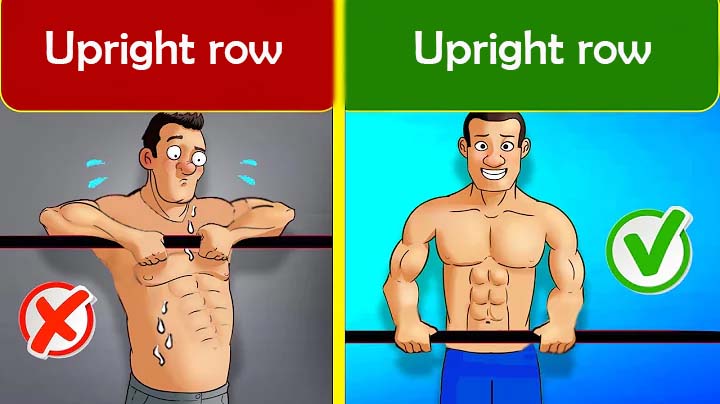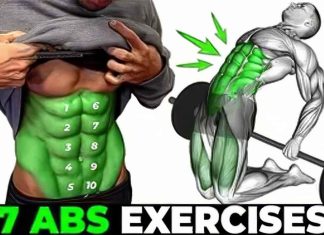How to Do Upright Row
Upright Row – this exercise aimed at growing the deltoid muscles is perfect for both men and women. This exercise is considered fundamental. It is aimed mainly at the development of the middle part of the deltoid, as well as trapezius muscles.

Benefits Upright Row with a Barbell
- A great option for training the deltoid muscles at home and in the gym.
- The exercise is suitable for both men and women.
- Perfectly trains both the anterior and middle bundle of deltoid muscles.
- Includes the work of the trapezius muscles
What muscles work?
- Middle and anterior bundles of the deltoid muscles, as well as the upper part of the trapezius muscles.
- In addition to the target muscles, the rhomboid muscles and biceps are involved.
Execution technique:
- The barbell must be taken with an overhand grip. It is very easy to place the brushes on the bar correctly, for this you need to put your thumbs on top of the neck so that they touch each other – this will be the correct setting of the hands.
- After that, you need to straighten up, slightly arching your back in the lower back. The shoulders should be straightened, and the arms should be straightened at the elbow joints.
- In the starting position, the bar of the bar should be near the hips.
- During the pull of the bar to the chin, the athlete exhales, and concentratedly raises the bar to the chin, tensing the deltoid muscles.
- Elbows should stretch vertically upwards.
- The movement is upright row by contraction (tension) of the deltoid muscles and leading the elbows up.
- Throughout the entire amplitude, whether up or down, the bar slides strictly in a vertical plane along the body.
- No need to hang over the barbell. Overhanging can provoke excessive deflection in the back.
- The chin should be in a horizontal plane throughout the movement.
- You do not need to tilt your head or lift it up.
- At the top of the amplitude, the elbow joint should form a thirty-degree angle.
- Take a short pause at the peak of the upward movement, then slowly lower the bar down along the same path.
Upright Row to the chin with a wide grip
It is generally accepted that the upright row to the chin with a wide grip is maximally directed to the work of the middle part of the deltoid muscles. Due to the wide location of the brushes on the barbell, the exercise replaces the dumbbell fly. At the top of the amplitude, the elbow joints should be above the hands. If during the exercise you do not fully extend your arms at the lower point of the amplitude, then the muscles will be in constant tension, thereby the pumping effect will be best.
Wide Grip Upright Row Technique
There is no particular difference between upright row with a wide grip and chin rows, however, when working with a wide grip, the following nuances must be taken into account:
- Hands-on the bar should be slightly wider than the shoulders.
- During the upward movement, the elbows are bred to the sides.
- There is no need to pause at the top point.
You can also do an upright row with dumbbells.
The Smith Machine Upright Row
The technique of performing in the Smith machine upright row is no different from the exercise with dumbbell upright row. The advantage of the Smith Machine Upright Row is that it is easy to do.
- Firstly, due to the movement of the bar along the guides, the thrust is carried out along the most correct trajectory.
- Secondly, it is possible to fix the weight at any time, for example, if there is discomfort in the shoulder, elbow, or wrist joint.
How to include Exercise in your Training Program
Here is a small training circuit using an upright row:
- Seated dumbbell press.
- Wide Chin Upright Row
- Press Arnold
- Dumbbells Flys
- Barbell Upright Row
- Reverse Cable Crossover
Women can perform the exercise by including it in a superset. Girls in any exercise on the deltoid muscles need to exclude the use of large weights. You can limit yourself to two or three sets of 15 to 25 repetitions.


























